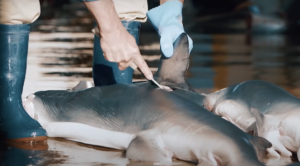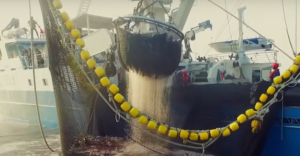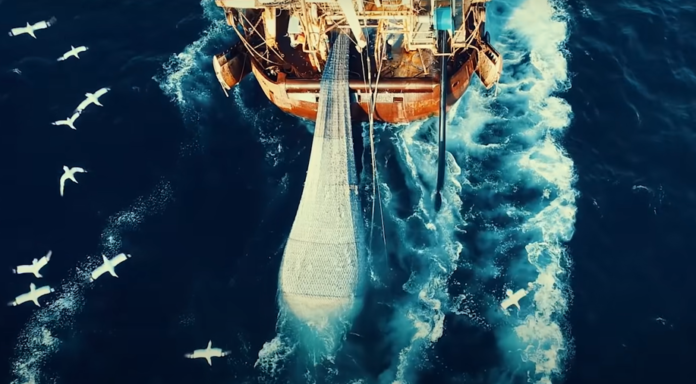What are we doing to our oceans? How can we put an end to all of this? These are the questions that will come to your mind while watching Ali Tabrizi’s latest documentary ‘Seaspiracy’. The 90-minute long film keeps you hooked and shocked till the end by throwing raw and disturbing facts about industrial fishing in your face. All the while, you will feel helpless for not being able to do anything to stop the madness going on in our oceans. There is a simple solution though – stop eating fish!
Seaspiracy has been made painstakingly by Tabrizi and his team, who put their lives at risk to expose the unethical, cruel and corrupt practices going on in the commercial fishing industry. Using undercover footage and secret cameras, the team has been able to unmask the various animal and human rights violations taking place in the industry, which gets billions of dollars in subsidies from governments around the world. Shielded by government officials and supported by some of the most well-known environmental and marine protection organisations, these fishing companies have been able to build multi-billion dollar businesses with utter disregard for marine life.
Seaspiracy begins by showing Tabrizi’s childhood fascination with underwater life. As he grew up, he wanted to capture the beauty of the oceans and the creatures who live in them. His excitement was cut short by the realisation that not all is as rosy as it seems. He starts reading about the problem of plastic in the oceans, and how it is killing whales everywhere. He also starts collecting plastic waste strewn across beaches regularly, and stops using single use plastic, such as straws, cutlery, toothbrushes, etc. He would later realise that the plastic problem was not just limited to all of the above; there was another, much bigger culprit!
Meanwhile, Japan announced that it is resuming commercial whaling in the Antarctic and is withdrawing from the International Whaling Commission. That would mean that it is free to continue killing whales. Restricted by logistical challenges of filming in the Antarctic, Tabrizi decides to go to Taiji, a place in southern Japan, to capture videos of the dolphin drive hunt in which dolphins and other cetaceans are driven to a small bay where they are killed for meat or for sale to dolphinariums. Before leaving, he meets Ric O’ Barry, founder of Dolphin Project, who has been working towards this cause for a long time. He says in the film, “They (the Japanese government) have been trying to get rid of anyone who are opposed to their war on dolphins.”
Immediately after reaching Taiji, Tabrizi and his team sees an entourage of police, secret service, and coast guard, following them everywhere. He is finally able to witness the dolphin drive hunt despite police chasing them throughout. These hunts are supported and funded by marine parks in the country, and a trained dolphin is worth over $100,000. He also finds out about another problem in Taiji – overfishing of Bluefin Tuna, the most expensive fish on the planet. Today, less than 3% of the species remain as the overfishing is driving them towards extinction. He tries contacting Mitsubishi, which controls 40% of the world’s tuna industry, to find out why they were wiping off an endangered species, but was denied an interview. Tabrizi faces similar response by different organisations throughout this documentary.
He finds out about the “heavily criminally involved and mafia-esque run” shark fin industry, which exports shark fins to several Asian countries, mainly China, where it is a delicacy and a status symbol. From whales and dolphins, Tabrizi’s focus moves to sharks and their importance in maintaining the ocean’s ecosystem. “If the sharks get finned into extinction, the ocean’s gonna turn into a swamp,” says shark activist Paul De Gelder in the film.



Seaspiracy then moves to the most dangerous threat to marine life – commercial fishing! It highlights the connection between commercial fishing and extinction of endangered species. Humans kill 11,000 to 30,000 sharks per hour, due to which several species of sharks have lost up to 80 to 99% of their populations. Almost half of these sharks are killed as a bycatch from fishing fleets, and are discarded as waste back into the ocean. Every year, 50 million sharks are caught in nets this way. Not just sharks, several other species also get killed by getting caught into fishing nets every day. Bycatch, which the industry refers to as ‘accidental take’, is by far one of the biggest reasons for driving ocean wildlife into extinction.
The documentary becomes highly engaging from this point on as it starts exposing the hypocrisy and corruption in some of the most famous charitable organisations and NGOs working in the area of marine protection. Marine Stewardship Council or MSC, which gives out ‘sustainable seafood’ certifications, does not get back to Tabrizi despite a series of one-sided communication. He wants to find out why is the organisation giving out such labels to companies that are clearly wiping off wildlife from the seas. With no hope in sight, he reaches out to Sea Shepherd, a vigilante organisation who has been trying to fill the bycatch law enforcement void, and going into harm’s way to safeguard marine life from illegal fishing. Capt. Peter Hammarstedt of Sea Shepherd Conservation Society tells Tabrizi, “The greatest threat to whales and dolphins is commercial fishing. Over 300,000 dolphins, whales and porpoises are killed every single year as a bycatch of fishing.”
Now, this is one number that is likely to shock you – 45 dolphins killed to catch eight tuna fishes! If this isn’t shocking enough, the film highlights that the fishing vessel responsible for this bycatch was working for a company that sells ‘Dolphin Safe’ canned tuna! The organisation that gives out this label is Earth Island Institute, and when Tabrizi interviews one of the spokespersons to find out more, he is met with rambling statements, incoherent answers, and confusion. “The internationally-recognised seafood label was a complete fabrication since it guaranteed nothing,” says Tabrizi.



The second half of Seaspiracy brings the focus back to the plastic problem in the ocean. The point raised now, however, is different. George Monbiot, an environmentalist, tells Tabrizi that no one, not even the groups talking about marine plastic, talk about discarded fishing nets and fishing gear, which form over 46% of the plastic waste in the ocean. Not only do they pollute but are highly dangerous for marine life “because they are designed to kill”. Fishing gear is the main trash in the stomachs of whales washed ashore dead and it is now present in some of the remotest places on the Earth. Here come some more shocking facts:
1) Longline fishing sets enough fishing lines to wrap around the entire planet 500 times every single day
2) Six out of seven species of sea turtles are either endangered or threatened. 1000 sea turtles die every year from plastic. However, in the US alone, 250,000 of them are captured, injured or killed every year due to fishing.
3) Organisations such as Greenpeace, WWF, Friends of the Earth, and Plastic Pollution Coalition, which are trying to tackle the problem of plastic waste are talking about everything else except fishing gear. These groups talk about plastic straws 99% of the time, which forms just 0.03% of plastic entering the ocean
4) Even if no plastic enters ocean, the ecosystems would still continue being destroyed by commercial fishing. It is more dangerous than plastic pollution and even oil spills!
5) Overfishing, not global warming, is one of the main causes of coral reef depletion
6) 2.7 trillion fish is caught every year and up to 5 million killed every single minute
Tabrizi encounters more incoherent answers and lies when he goes to interview representatives of organisations such as Plastic Pollution Coalition. He then decides to follow the money. After a brief research, he finds that the Plastic Pollution Coalition is a project of Earth Island Institute. “Of course, they are not going to talk about fishing nets,” Tabrizi says.
The documentary Seaspiracy gives you chills when it states the research-backed fact “if the current fishing trends continue, we would see empty oceans by the year 2048!” It highlights that marine life has a far more important role to play in maintaining global temperatures than thought earlier. Sylvia Alice Earle, the famous American marine biologist, tells Tabrizi, “Leaving trees or planting trees really helps the carbon equation, but nothing matter more than maintaining the integrity of ocean systems. The ocean is the biggest carbon sink on the planet.”
Seaspiracy then shifts its focus to the most destructive form of fishing – trawling. The huge fishing nets used in trawlers drag along the ocean surface, eliminating all forms of vegetation and marine life in the area. Fishing trawlers wipe out 3.9 billion acres of seafloor deforestation every year, which is equivalent to losing 4,316 soccer fields every single minute. Despite this, no environmental group is talking about this! Capt. Paul Watson, the founder of Sea Shepherd, comments, “A lot of these groups aren’t interested in solving the problem, they are interested in exploiting the problem.”
Oceana, the world’s leading marine conservation organisation, nowhere mentions anything about reducing or eliminating seafood consumption, rather it suggests eating sustainable seafood. Tabrizi decides to find out more on sustainable seafood, for which he meets Maria-Jose Cornax from Oceana. Once again, he was met with the same kind of response. He tries contacting MSC again but in vain. Tabrizi again decides to follow the money and finds a massive conflict of interest.
One of the founders of MSC was the Unilever Corporation, which was then a major seafood retailer. Over 80% of their income comes from licensing their logo to seafood companies. So, it is obvious that these organisations would never say anything against commercial fishing!
The second half of the documentary talks about human rights violations, especially in the Thailand’s shrimp and prawn industry. This aspect is often hidden from public sight as no one actually knows what happens at the sea. Tabrizi interviews former shrimp industry slaves, who describe the immense torture they had to endure for years on fishing vessels. One former slave recounts the horror and tells Tabrizi how the owners would splash them with boiling water, hit them with iron bars, and threaten them with a gun. They were made to live next to the freezers containing dead bodies of other slaves. Sometimes, they would throw young boys into the sea. “A lot of the seafood we eat today comes from forced labour,” he says.
Seaspiracy also unravels the severe consequences of illegal fishing in that takes place around African coastline. It shows the link between illegal fishing by European countries in this region and food shortage, breakout of zoonotic diseases such as Ebola, poverty and piracy. To learn more about this, Tabrizi accompanies the Sea Shepherd team who raid illegal fishing vessels off the Liberian coast. After being able to catch an illegal ship, Tabrizi learns that the amount of damage they cause to the marine wildlife is beyond imagination. Some disturbing shots show majestic species such as humpback whales, hammerhead sharks, and tortoises being caught in the nets, as they desperately try to save themselves from imminent death.
Seaspiracy is a masterpiece that brings out the message loud and clear. Besides talking about some known facts, the film has been able to show the sinister face of environment protection organisations, which only seem to be interested in bluewashing, rather than going to the root cause of the problem. Tabrizi and his team deserve appreciation for bringing the truth out into public domain. It is a must-watch for everyone.
Message from Seaspiracy – Stop Eating Fish!


